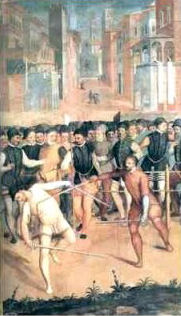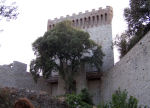Situated on a small promontory on the lake, the fortified town is still surrounded by its ancient walls and its distance from the modern residencial zone keeps it unaltered. First a town of fishermen then an agricultural area, Castiglione del Lago is now one of the most important tourist centers around lake Trasimeno. Due to the strategic position that made it the most mportant military center of the area it was contended during the Middle Ages by Perugia, Arezzo, Siena, Firenze. At the end of 12th century it fell definitively to Perugia, and during the following century Frederic II of Swabia ordered the reconstruction of the town and the castle in the way in which they have survived - with few changes - until today. Having become the most important military settlement of the Papal State, the territory was conceded in the second half of the 16th century by Pope Julius III to his nephew Ascanio Della Corgna, in 1563 it was elevated to the status of marquisate. In 1623 the territory was transformed into a dukedom, thought only for one generation as Duke Fulvio Alessandro died without male heirs, and the town was again part of the Papal Administration. In 1870 the Palace was bought by the Comune of Castiglione del Lago that used it as its seat. Recently it has been transformed into a museum.
The Palace of the Della Corgna family was built starting in 1563, in consequence of Ascanio's acquisition of the title of marquis of Castiglione. Conceived as a small royal palace, it was completely isolated from the rest of the village and afterwards completed by luxuriant gardens - praised by men of letters and poets - which are unfortunately no longer extant. The original nucleus was made up of one or two habitable towers from the 13th century, than transformed at the beginning of the 16th century into a hunting lodge by the Baglioni family. The design of the Palace has been ascribed both to Vignola and to Galeazzo Alessi - it is possible that they worked on it together. The piano nobile, today the first stage of a visit to the museum, is divided into three main parts: the central one (entrance and three halls) and the eastern one (five rooms) are all frescoed by Niccolò Circignani called "Pomarancio", whereas the western one, with three rooms which were probably for servants, has white walls. In the first half of 16th century was built on the west side another part of the Palace and this addition determined its characteristic L-shape. In 1824 the Palace was destroyed by a fire and in 1870 was bought by the Comune.

The marquis Ascanio della Corgna
There is a legend that
on every anniversary of Ascanio's death (3 december)
his ghost appears in front of the Palace!!
The Castello del Leone - from which comes the latin name of the village: Castillonem then Castiglione - is an elaborate fortification, whose construction ordered by Frederic II of Swabia, was begun around 1247. He wanted to @include it in the central defensive system that, starting from Puglia, crossed the whole of Italy. The entire ancient village was destroyed and rebuilt following new parameters, possibly under the supervision of Friar Elia da Cortona, a contemporary of Saint Francis and a former general director of the franciscan order who then moved to the emperial ranks and who was also responsible for the design of the Saint's Basilica in Assisi. On the death of Frederic II, three years later, Perugia took possession of one of the most solid military structures of central Italy and in the following decades decided to complete the emperial plan. The fortress has an irregular pentagonal shape with four towers in the corners and the triangular "mastio" (the highest tower) about thirty metres high. The round and the square towers to the south are from the 13th century, coeval with the fortress; the other two round towers replaced the preceding ones in the 15th and 16th century because the round surface was a better defence against the cannonfire.
 The"mastio" |


